Lead and Copper Rule Compliance

.jpg) Water providers treat the water with a specially
Water providers treat the water with a speciallyPolyphosphates FAQ
Click below for our interactive map. Click here for the Water Service Line Inventory.

INFO and FAQ
The LCR has seen a number of revisions in the last 3 decades, however, recent developments have inspired additions to the rule which now includes:
- Establishing a trigger level to jumpstart mitigation earlier and in more communities.
- Driving more and complete lead service line replacements.
- For the first time, requiring testing in elementary schools and child care facilities by the water system operator.
- Requiring water systems to identify and make public the locations of lead service lines.
- Better informing our residents
- Provide clear and concise information on the health impacts of lead
- Alert residents in homes with lead or suspected lead service lines of what they can do to mitigate their own risk
- Maintaining a list of all water service taps connected to the Village water system
- Monitoring and treating the water as needed to minimize the chances of lead leaching into drinking water
- Coordinating with schools and daycare facilities to test water and better protect our kids
- Testing on a three-year cycle from IEPA approved homes
- Last sampled: summer of 2020. Results: 90th percentile 1.4 ppb (parts per billion)
- Due to the Village's reduced risk, our sampling requirements are at 3-year intervals
| If you have received a known lead service line notification letter, give the Water Division a call at 847-459-2545. We have knowledgeable staff here to help. |
Educate yourself: What does a lead service look like?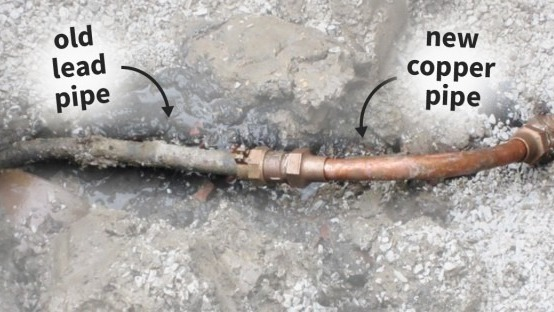
Take These Important Steps to Reduce Lead in Drinking Water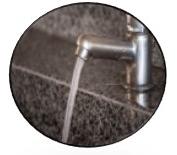 Run you water before drinking after 6+ hours of no water use.
Run you water before drinking after 6+ hours of no water use.
Flush your home's pipes by running the tap, taking a shower, doing laundry, or doing a load of dishes. 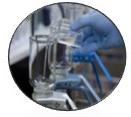 Have your water tested.
Have your water tested.
Private companies will test water for a fee or you can purchase at home water testing kits. 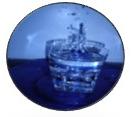 Use cold water.
Use cold water.
Pipes and plumbing in homes buildings can contain various amounts of lead, which is more likely to leach into the water when it is hot. 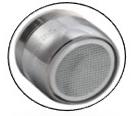 Clean your faucet aerator screen.
Clean your faucet aerator screen.
Sediment, debris, and lead particles can collect in your aerator and get into your water.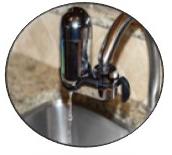
These systems can filter out contaminants like lead. Reverse Osmosis can remove up to 99.1% of lead in water.
What are polyphosphates?
Polyphosphates are water treatment chemicals used to solve specific water quality problems resulting from inorganic contaminants (iron, manganese, calcium, etc.) in ground water supplies and also to maintain water quality (inhibit corrosion, scale, biofilm, reduce lead and copper levels) in the distribution system. Polyphosphates are used in water treatment along with many different phosphate compounds that exist for use in the water treatment process. Polyphosphates work together, stabilizing water quality and minimizing color, scale, deposits, corrosion, and chlorine demand in drinking water systems.
What are the problems that polyphosphates help to solve?
Polyphosphates are used in residential water systems to perform three broad functions: inhibit corrosion of plumbing and plumbing fixtures and sequester nuisance metals in the water supply (iron, manganese, calcium, magnesium). They can also improve the quality of water in the home by removing scale deposits & tuberculation, discourage microbial film formation/regrowth, and stabilizing free chlorine municipal water treatment disinfectant residuals.
How do polyphosphates work in a water system?
Polyphosphate type chemicals react with soluble metals (iron, manganese, calcium, magnesium, etc.) by sequestering (bind‐up) the metals to maintain their solubility in water. The polyphosphate sequestering process minimizes the risk of discoloration, staining, scaling, taste/odor and other water quality complaints.

Are polyphosphates safe and approved for water systems?
Various forms and purity grades of polyphosphates exist. All polyphosphate additives to Buffalo Grove’s municipal water are certified to ANSI/NSF Standard #60 Drinking Water Treatment Chemicals as approved for use in potable drinking water. The polyphosphates are included in the water at very low levels. In fact, most concentrations are well below those allowable in foods when utilized as thickeners, stabilizing agents, and emulsifiers.
What other benefits of polyphosphate treatment exist?
Polyphosphates easily adapt to any pre‐existing water quality without changing the water chemistry. Referred to sequestrates, polyphosphates have a selective function, yet wide range of performance. Primary treatment benefits include: corrosion control, lead/copper control, sequestration of iron/manganese, control of calcium carbonate scale, and water softening, etc.
